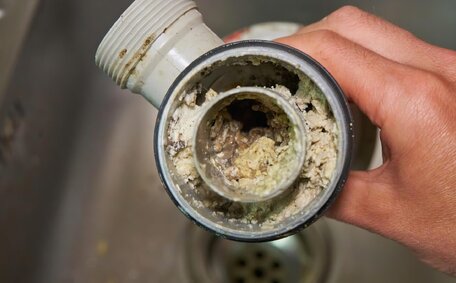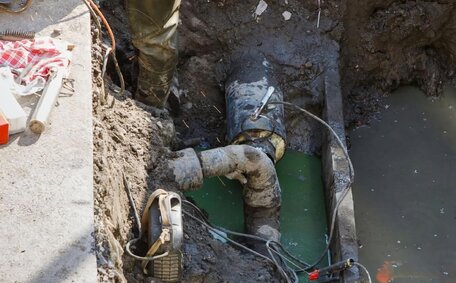Introduction to Pipe Relining and Replacement
Household and commercial plumbing systems often contend with issues like leaks, corrosion, and blockages over time, threatening the integrity of the infrastructure inside your residence or business. This article examines the repair options of pipe relining versus pipe replacement, determining their effectiveness and appropriate contexts for use.
Pipe relining rejuvenates your plumbing system by internally repairing pipes with epoxy resin, bypassing the need for extensive excavation. In contrast, pipe replacement requires completely removing and installing a new system through excavation. Each repair method provides distinct advantages, with the choice between them often dependent on the severity of pipe damage.
As specialists in pipe repair method addressing concerns like tree root intrusion, we’ve put together a detailed comparison on aspects like disruption, longevity, and cost for your pipe solutions. Our goal is to furnish your property’s sewer lines with the right knowledge for a swift, informed relining job decision.
How Pipe Relining and Replacement Work
The trenchless pipe relining process fortifies existing pipes within your home, eliminating the concern for disruptive trenching or excavation. A resin-saturated liner is carefully positioned inside the compromised pipes and subsequently expanded.
This stands in contrast to traditional repair methods, where blocked pipes must be unearthed for total removal and overhaul. Such excavations often involve digging up extensively to access your piping infrastructure, risking potential damage to your yard that lawns and gardens may suffer.
Pipe relining instead reinforces your blocked damaged pipes without full excavation, avoiding weeks of construction, unlike when being replaced with new piping entirely. It can also result in less waste compared to discarding old pipe systems. However, pipe replacement allows for adjacent system inspections and enables the substitution of pipes if they’re significantly damaged.
Pipe Materials Compatible with Relining
Relining can make your pipes effective again, mending a broken pipe made from a range of materials including PVC, concrete, clay, galvanised steel, copper, and cast iron. It works for pipes with a diameter of 2 inches or more that are not extremely fragile or collapsed.
While very deteriorated pipes may still need full replacement, drain relining can often restore function in broken pipes made from materials like:
- PVC pipes - A common modern material prone to cracks and breaks, requiring more attention than some other durable materials.
- Galvanised steel - Susceptible to corrosion and buildup restricting flow.
- Clay - Found in older properties and naturally brittle over time.
- Concrete - Vulnerable to cracks, which makes it susceptible to tree roots invasions that can undermine the structure and cause leaks.
The pipe relining method does pipe relining effectively by fashioning a pipe inside another, wherein the inner walls are coated with toughened epoxy resin, bolstering your pipes against future wear and damage. This process is designed to make your pipes stronger, enhancing their resilience without necessitating underground disruption.
It’s incorrect to assume material types limit pipe relining suitability; the age and damage extent are more significant determinants. Our seasoned professionals can assess your needs to ensure they deliver relining solutions that align with the best strategy for your plumbing requirements.
Comparing Costs: Relining vs Replacement
Costs factor heavily in comparing pipe relining and replacement, with relining often emerging as the more economical choice. Typically, relining costs range from $80-250 per metre, while replacement can command $200-500 per metre, the latter figure varying with the pipe material and excavation requirements.
Factors such as drain pipe accessibility and property damage play a role, generally leading to costs less than property-intensive full replacement. Replacements can be more expensive, often necessitating the removal of fences, extensive landscaping destruction, and driveway access, thus inflating the total cost. Since relining uses existing pipe access points and is minimally intrusive, it incurs no additional property restoration costs.
There are also long-term savings, as when you opt for pipe relining services and they’re correctly applied, epoxy resins can ensure your pipe last for over five decades. Even though flushing services might be necessary intermittently, sewer repair is required more often than not with brand new piping installations. This prevents recurring costs from pipe replacements down the track.
To understand the best value option for your property, we encourage readers to email or call North Mead Plumbing. Our team provides tailored quotes considering the condition of your pipes and your specific scenario, ensuring a custom approach to pipe relining which addresses your individual needs.
Time and Disruption Comparison
The benefits pipe relining offers over than traditional methods become clear when assessing the time involved and upheaval, with relining proving to be far less disruptive. Relying on relining sewer pipe, the resin-coating process is less disruptive, often completed within just 1-2 days with no excavation required. Technicians can access pipes through existing openings like manholes or cleanouts, avoiding the excavation of deep trenches.
In contrast, the pipe replacement process involves weeks of extensive digging, removing old pipes, installing a new one, and repairing any surface-level damage, such as landscaping or driveways. Properties may also require partial closure if the existing piping needs to replace damaged components with new infrastructures.
There is minimal disturbance to your life or day-to-day operations.
Once technicians complete the resin installation and curing, normal water flow quickly resumes, successfully concluding the steps to repair your plumbing issues.
Severely damaged pipes on the brink of collapse necessitate total replacement for effective drainage. However, in less critical cases, epoxy relining offers robust reinforcement, completing the task much faster than an entire system overhaul.
Environmental Impact
On the other hand, one of the biggest environmental benefits pipe relining has over full replacement is the minimal land disruption. As no significant excavation is required, the process eradicates the need to dig up your garden, safeguarding the aesthetics of your yards and landscaping.
Pipe replacement takes longer and generates construction waste, including discarded old sewer pipes and other materials unearthed during the process. Proper disposal of these can be difficult and contributes to landfill volumes, not to mention the potential to damage your landscape. Through pipe relining, we get job done efficiently while avoiding the waste issue by preserving existing infrastructure.
The resin materials used to reline pipes are also considered more eco-friendly compared to some piping like concrete or PVC. With superior durability and longevity, ensuring fewer repairs, sewer drain integrity is maintained reducing future waste.
For property owners who are sustainability-conscious and need sewer solutions, choosing pipe relining may ensure they don’t end up contributing to the problem of excess landfill. The relining process emits less carbon by not requiring heavy machinery and reduces the need for repeated replacements.
As industry experts, our familiarity with the latest plumbing trends ensures we know the optimal approaches, and we’re proud to offer relining as an innovative, low-impact solution. Maintaining the functionality of relined pipes no longer comes at the expense of environmental harmony.
Durability and Lifespan
A major advantage of sewer pipe relining is its enhanced durability and extended lifespan. With correct application, epoxy resin liners can maintain structural integrity for roughly 50 years, postponing the need for subsequent replacements.
Conversely, traditional pipe systems using materials like PVC and galvanised steel typically last 20-30 years before needing replacement. Copper may reach 50 years, but depends heavily on water chemistry and prevalence of leaks or blockages.
Relining protects the inner epoxy layer from external threats by forming a 'pipe within a pipe,' preventing exposure and corrosion. Routine CCTV inspections monitor the liner’s condition, enabling preemptive removal of obstructions to preserve pipe integrity.
In severe damage cases needing complete replacement, new pipes still risk future failure. But a single quality relining service can reinforce your pipes for the rest of your occupancy, providing enduring leak protection and flow.
When to Choose Relining or Replacement
The decision between pipe relining and full replacement depends on variables like the severity of damage, pipe material, age, accessibility, and cost considerations. Our experts conduct thorough evaluations to guide you towards the most suitable repair option for your circumstances.
With minor to moderate damage such as cracks or leaks, relining frequently restores pipe functionality at a lower cost than replacement. If degradation is moderate, epoxy resins can significantly prolong the life of compromised systems. This method is apt for unblocking drains and repairing older but intact pipes made of materials like galvanised steel, concrete, and clay, which are susceptible to gradual decay.
Nevertheless, the following situations may necessitate considering the alternative of pipe replacement:
- When pipes are critically damaged, collapsed, or near complete failure, full replacement is the only viable solution.
- Materials like polybutylene piping are unsuitable for epoxy lining application.
- Fixtures cause frequent clogs unaffected by relining, like undersized drainage.
- When piping layouts are inaccessible, making it impossible to thread liners through, full replacement is the needed last resort.
To determine the most appropriate repair strategy, skilled plumbers undertake detailed inspections, including CCTV surveys and pressure testing, to confirm that the selected method matches your pipe specifications. By evaluating the extent of the damage, material condition, size, and accessibility, our team can advise on whether reinforcement or complete replacement will provide a durable solution for your plumbing system.
While pipe relining suits many scenarios, some cases may necessitate full excavation. Discover more by contacting our plumbing company, North Mead Plumbing, for long-lasting epoxy liners or to receive a fair replacement estimate if beyond repair.
Pros and Cons of Each Method
Comparing the advantages and limitations of pipe relining with full replacement, it is evident that each method bears unique benefits tailored to your property’s specific needs:
Pros of relining:
- More cost-effective - Generally ranging from $80 to $250 per foot compared to $200 to $500 for replacement
- Quicker process, typically completed in a few hours to 1-2 days
- Minimally invasive with no digging or demolition
- Long lifespan of 50+ years from epoxy resins
- Eco-friendly with less waste and emissions
Cons of relining:
- Impractical for extensively damaged or narrow pipes






